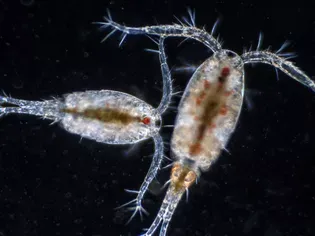How to Culture Amphipods and Copepods (for Aquarium Owners)
Updated on 04/26/24

Master the Art of Culturing Microcrustaceans: A Comprehensive Guide for Aquarium Enthusiasts
Introduction
In the realm of aquarium keeping, microscopic organisms play a crucial role in maintaining a thriving ecosystem. Among these tiny creatures, amphipods and copepods stand out as essential food sources for numerous aquatic species, from delicate seahorses to active dartfish. Culturing these microcrustaceans at home empowers aquarium owners with the ability to provide a consistent, nutritious diet for their beloved inhabitants. This comprehensive guide will delve into the intricacies of culturing amphipods and copepods, equipping you with the knowledge and techniques to establish thriving colonies in your own aquarium system.
Understanding Amphipods and Copepods
Amphipods
Amphipods, also known as scuds, are small crustaceans that resemble miniature shrimp. They possess a wide range of physical characteristics, varying in size, shape, and color. Amphipods play a vital role in the aquarium as scavengers, consuming algae, detritus, and other organic matter. They are also a favorite food for many fish species and can aid in maintaining a clean and balanced aquarium environment.
Copepods
Copepods are even smaller crustaceans that are often referred to as "water fleas." They are free-swimming organisms that can propel themselves through the water with their segmented, paddle-like appendages. Copepods are a highly nutritious food source for a wide range of marine and freshwater species, including fry, invertebrates, and certain fish.
Benefits of Culturing Amphipods and Copepods
* Nutritional Value: Both amphipods and copepods are excellent sources of protein, lipids, and other essential nutrients for aquarium inhabitants.
* Live Food: Culturing your own microcrustaceans provides your fish and other animals with a live food source, which is often more nutritious and stimulating than frozen or prepared foods.
* Natural Behavior: Feeding live microcrustaceans encourages natural feeding behaviors and hunting instincts in your aquarium animals.
* Water Quality: Amphipods and copepods help maintain water quality by consuming waste and excess nutrients, contributing to a healthier ecosystem.
* Self-Sustaining: Cultured microcrustaceans can become self-sustaining, reducing the need for frequent feeding and maintenance.
Methods for Culturing Amphipods and Copepods
Culturing Amphipods
* Tank Size: Start with a small tank, such as a 10-gallon aquarium, dedicated to amphipod culture.
* Substrate: Provide a variety of substrates for amphipods to hide and graze on, such as live rock, PVC pipes, or artificial plants.
* Water Parameters: Maintain water parameters suitable for the specific amphipod species you are culturing. This typically includes a salinity range of 1.020-1.025 and a pH of 8.0-8.5.
* Feeding: Feed amphipods a variety of foods, including algae, fish flakes, and spirulina.
Culturing Copepods
* Tank Size: Copepods can be cultured in even smaller containers, such as 5-gallon buckets or jars.
* Substrate: A fine-grained substrate, such as sand or mud, is ideal for copepod cultivation.
* Water Parameters: Copepods prefer slightly brackish water with a salinity range of 1.005-1.015 and a pH of 7.8-8.5.
* Feeding: Copepods feed on a variety of microorganisms, such as phytoplankton, zooplankton, and detritus.
Monitoring and Maintenance
* Observe Regularly: Pay attention to the behavior and appearance of your microcrustaceans to detect any signs of distress or disease.
* Water Changes: Perform regular water changes to maintain water quality and prevent the accumulation of waste.
* Harvesting: Harvest microcrustaceans responsibly to avoid overfishing and maintain a healthy population in your culture tank.
Troubleshooting
* Poor Growth: Ensure that water parameters are suitable, provide sufficient food, and address any potential stressors in the culture tank.
* Die-offs: Investigate the cause of any sudden die-offs, such as water contamination, disease, or overcrowding.
* Algae Blooms: Control algae growth through regular water changes and by providing sufficient grazing surfaces for amphipods and copepods.
Conclusion
Culturing amphipods and copepods is a rewarding and beneficial practice for aquarium owners. By providing a consistent source of live, nutritious food for your aquatic inhabitants, you can promote their health and well-being while enhancing the overall ecosystem of your aquarium. With the techniques outlined in this comprehensive guide, you can successfully establish thriving microcrustacean colonies and reap the numerous benefits they offer. Remember to monitor your cultures carefully, maintain optimal water conditions, and harvest responsibly to ensure the long-term health and sustainability of your microcrustacean populations.
Explore More Pets

Freshwater Aquarium Filters
How to Deal With Cloudy Aquarium Water

Saltwater Aquarium Filters
How Do You Remove Chloramines From Tap Water?

Freshwater Aquariums & Habitat
Can I Keep My Koi Fish Inside?

Saltwater Aquariums & Habitat
14 Best Floating Plants for Your Aquarium

Freshwater Fish Health
How to Treat Ich on Freshwater Fish

Saltwater Fish Health
Fin Rot in Aquarium Fish

Freshwater Aquarium Filters
How to Do Aquarium Water Changes

Saltwater Fish Health
How Do Fish Get Parasites?